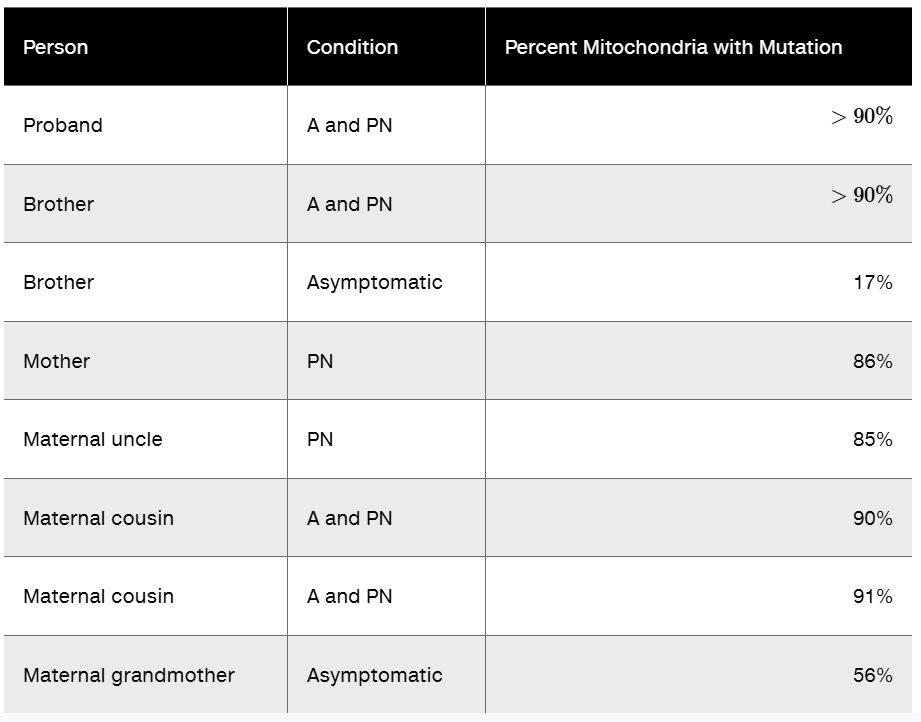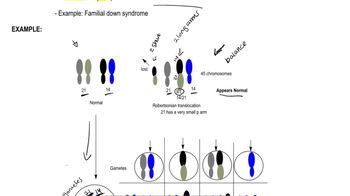The following pedigree shows a family in which several individuals exhibit symptoms of the mitochondrial disease MERRF. Two siblings (II-2 and II-5) approach you to inquire about whether their children will also be afflicted with MERRF. What do you tell them?
Table of contents
- 1. Introduction to Genetics51m
- 2. Mendel's Laws of Inheritance3h 37m
- 3. Extensions to Mendelian Inheritance2h 41m
- 4. Genetic Mapping and Linkage2h 28m
- 5. Genetics of Bacteria and Viruses1h 21m
- 6. Chromosomal Variation1h 48m
- 7. DNA and Chromosome Structure56m
- 8. DNA Replication1h 10m
- 9. Mitosis and Meiosis1h 34m
- 10. Transcription1h 0m
- 11. Translation58m
- 12. Gene Regulation in Prokaryotes1h 19m
- 13. Gene Regulation in Eukaryotes44m
- 14. Genetic Control of Development44m
- 15. Genomes and Genomics1h 50m
- 16. Transposable Elements47m
- 17. Mutation, Repair, and Recombination1h 6m
- 18. Molecular Genetic Tools19m
- 19. Cancer Genetics29m
- 20. Quantitative Genetics1h 26m
- 21. Population Genetics50m
- 22. Evolutionary Genetics29m
2. Mendel's Laws of Inheritance
Pedigrees
Problem 19b
Textbook Question
Researchers examined a family with an interesting distribution of Leigh syndrome symptoms. In this disorder, individuals may show a progressive loss of motor function (ataxia, A) with peripheral neuropathy (PN, meaning impairment of the peripheral nerves). A mitochondrial DNA (mtDNA) mutation that reduces ATPase activity was identified in various tissues of affected individuals. The accompanying table summarizes the presence of symptoms in an extended family.

Provide an explanation for the pattern of inheritance of the disease. What term describes this pattern?
 Verified step by step guidance
Verified step by step guidance1
Step 1: Recognize that the disorder described in the problem is associated with mitochondrial DNA (mtDNA). Mitochondrial DNA is inherited maternally, meaning it is passed down from the mother to all her offspring, regardless of their sex.
Step 2: Note the variability in symptoms and the percentage of mitochondria with the mutation in different individuals. This variability is due to heteroplasmy, a condition where cells contain a mixture of normal and mutated mtDNA. The proportion of mutated mtDNA can influence the severity of symptoms.
Step 3: Observe that individuals with a higher percentage of mutated mtDNA (>90%) exhibit more severe symptoms (ataxia and peripheral neuropathy), while those with lower percentages (e.g., 17% or 56%) are asymptomatic or have milder symptoms. This demonstrates a threshold effect, where symptoms manifest only when the proportion of mutated mtDNA exceeds a certain level.
Step 4: Identify the pattern of inheritance as maternal inheritance, as the mutation is passed down through the maternal line (e.g., mother, maternal uncle, maternal cousins, and maternal grandmother). This is consistent with the inheritance of mitochondrial DNA.
Step 5: Conclude that the term describing this pattern of inheritance is 'mitochondrial inheritance,' which is characterized by maternal transmission and variability in symptom severity due to heteroplasmy and the threshold effect.
 Verified video answer for a similar problem:
Verified video answer for a similar problem:This video solution was recommended by our tutors as helpful for the problem above
Video duration:
3mPlay a video:
Was this helpful?
Key Concepts
Here are the essential concepts you must grasp in order to answer the question correctly.
Mitochondrial Inheritance
Mitochondrial inheritance refers to the transmission of genetic traits through mitochondrial DNA (mtDNA), which is inherited exclusively from the mother. This pattern of inheritance is significant because mutations in mtDNA can lead to various disorders, such as Leigh syndrome, affecting energy production in cells. In families with mitochondrial disorders, all offspring of an affected mother may show symptoms, while fathers do not pass on mtDNA.
Recommended video:
Guided course

Organelle Inheritance
Leigh Syndrome
Leigh syndrome is a severe neurological disorder characterized by progressive loss of mental and movement abilities, often leading to early death. It is associated with mitochondrial dysfunction, particularly affecting ATP production due to mutations in mtDNA. Symptoms can vary widely among individuals, even within the same family, highlighting the complexity of mitochondrial diseases and their expression.
Recommended video:
Guided course

Robertsonian Translocations
Penetrance and Expressivity
Penetrance refers to the proportion of individuals with a specific genotype that actually express the associated phenotype, while expressivity describes the degree to which a phenotype is expressed. In the context of Leigh syndrome, the varying percentages of mitochondria with mutations among family members illustrate differences in penetrance and expressivity, leading to some individuals being asymptomatic despite carrying the mutation.
Recommended video:
Guided course

Penetrance and Expressivity
Related Videos
Related Practice
Textbook Question
852
views


